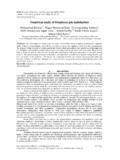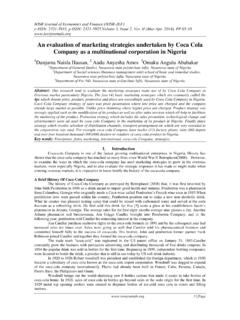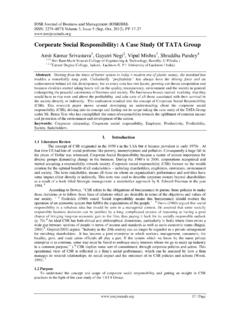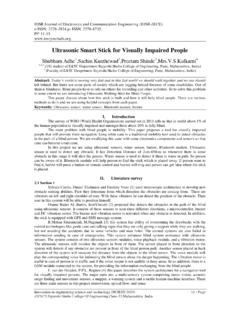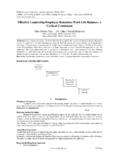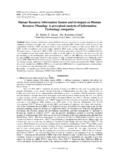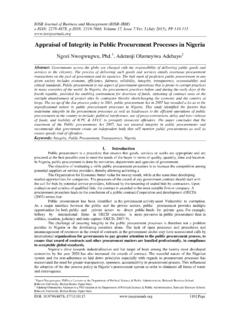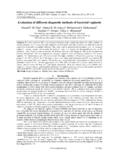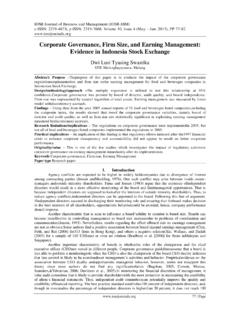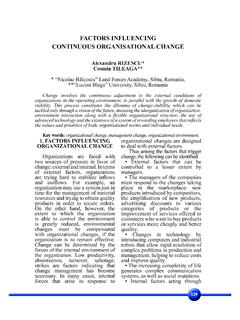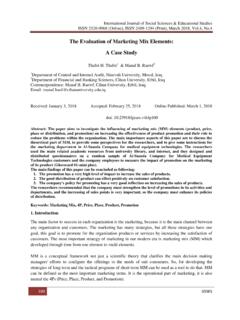Transcription of Literature Review on Leadership Theories
1 IOSR Journal of Business and Management (IOSR-JBM) e-ISSN: 2278-487X, p-ISSN: 2319-7668. Volume 19, Issue 11. (November. 2017), PP 35-43 DOI: 35 | Page Literature Review on Leadership Theories Sultan Aalateeg1 1(Business Administration Department/ Almajmaa University, Saudi Arabia. PhD Candidate of Economics and Management of Technology, University of Pavia, Italy) Abstract: The Leadership research in the last two decades evolved mainly under the following philosophies : trait school, focused on leaders dispositions ; behavioral school, concerned with leaders behaviors ; contingency school, focused on Leadership contingencies; relational school, considered leader-follower relations; sceptics school, questioned the existence and need of Leadership ; information-processing school, focused on cognition; and the neo-charismatic or transformational school.
2 Definitions of Leadership and different Theories were reviewed in this paper. Keywords: Leadership , Manager, Theory ---------------------------------------- ---------------------------------------- ---------------------------------------- --------------- Date of Submission: 25-10-2017 Date of acceptance: 16-11-2017 ---------------------------------------- ---------------------------------------- ---------------------------------------- --------------- I. Introduction The shift towards recognizing the importance of human capital in industrial age has led companies, and organizations, to change their paradigms about people management.
3 Most organizations no longer see employees as a resource whose primary function is to provide goods and services, but rather are seen as critical to their capability of providing quality services (Farzad, 2006, p. 12) and their ability to grow and evolve continuously. The success of any organization is dependent upon the collection of individuals, including leaders and subordinates, and the amount of effort everyone put into it. To understand organizational effectiveness, many researchers and practitioners have developed various studies to determine Theories regarding Leadership , organizational commitment, and job satisfaction . (Cheng, 2003, p.)
4 1). In their Review of Literature , Wallace and Weese found that ineffective Leadership to be the major cause of declining industrial productivity and a downward positioning of North American corporations on a global scale (Wallace & Weese, 1995, p. 182). One reason for examining the Leadership style is because research can help identify critical skills needed by leaders in today s world, where effective Leadership can be the key success in many organizations. While examining the impact of leader behavior on role stress characteristics and ultimately on organizational commitment in a large manufacturing cooperation in Midwest, Dale & Fox (2008) found a positive linkage between leader style and organizational commitment.
5 They concluded that when subordinates perceive that the supervisor exhibits a high level of initiating structure, the supervisor is formalizing the work environment or providing formal rules and procedures for employees to follow. As a result, employees perceive higher felt responsibility and thus have higher affective commitment. Burns (1978) pointed out that Leadership is one of the most observed phenomena on earth, but the least understood. It is often regarded as the most critical factor in the success or failure of an institution (Bass, 1990a). However, leaders must understand their impact on employees, and ultimately the organization.
6 Leaders mobilize employees toward commitment (Gardner, 1990). Whilst the interest in Leadership is growing in its perceived importance to business, the interest in exploring its nature, and attempting to identify what makes for effective Leadership , is by no means new (Nave 2005). Early Leadership studies focused on trait and behavior Theories . Trait approach emphasizes attributes of leaders such as personality, motives, values and skills. However, researchers have realized that there is no trait would guarantee Leadership success (Yukl, 2002, ). Then researchers had turned to study the behavior of the leaders and how this would affect their followers.
7 The success is a joint interaction between them in accordant to the situation; this had led to emergence of Situational approach. Situational Leadership theory as presented by Hersey and Blanchard which hypothesizes the importance of a manager s relationship orientation and task orientation in conjunction with effectiveness. However, they had modest success in identifying consistent relationships between patterns of Leadership behavior and group performance (Robbins, 1997, p. 419). Literature Review on Leadership Theories DOI: 36 | Page II. Leadership Leadership is a subject that has long excited interest among people.
8 The term connotes images of powerful, dynamic individuals who command victorious armies, direct corporate empires from top gleaming skyscrapers, or share the course of nations (Yukl, 2002, p. 1). Burns has written, Leadership is one of the most observed and least understood phenomena on earth (Burns, 1978, p. 2). From the beginning of civilization, history has been concerned with the study of its leaders and Leadership still an area of active inquiry. Indeed, Leadership is often regarded as the single most critical factor in the success or failure of institutions (Bass, 1990a). The discussion of Leadership as a process may have been originated by Machiavelli in the sixteenth century (Smith, et al, 1989).
9 However, a more systematic analysis of Leadership , add Smith et al, may have only been advanced by Max Weber in early last century. For Weber (1946) Leadership rested in three possible sources ( ideal-types ) of authority: charismatic authority, reflected personal characteristics; traditional authority, referred to compliance with norms and forms of conduct; and legal authority, which resulted from functional duty of office . Since Weber, research on Leadership has developed more systematically giving way to an array of theoretical perspectives and conceptual definitions (Bass, 1990a; Yukl, 2002). The study of Leadership began in the twentieth century was initially concerned with leader effectiveness (Yukl, 2002).
10 Researchers define Leadership according to individual perspectives; Stodgill (1974) concluded that there are almost as many definitions of Leadership as there are persons who have attempted to define the concept. (Lok, 2001). Leadership has been defined in terms of traits, behavior, influence, interaction patterns, role relationships, and occupation of an administrative position (Yukl, 2002, ). Table (1) shows some representative definitions. Table 1. Leadership Definition No. Leadership Definition 1. Leadership is the influence increment over and above mechanical compliance with the routine directives of the organization.
